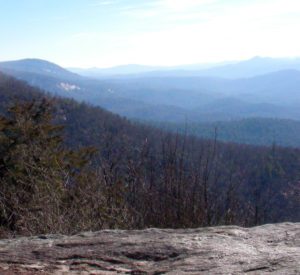Phase Two: Initiation
In the Initiation phase, the hero must “die to herself.” Many religious and shamanic rituals involve a symbolic death and rebirth to a new way of being. Initiation is an emptying of your cup so that it may be refilled with new knowledge. For a spiritual seeker, Initiation means being open to new experiences and being willing to experiment with new ways of being.
Session 6 The Road of Trials
Glad to find that he was not dead, Coyote looked up to see what had become of the dancers. The cavern was empty. All that remained of the fire were the dying embers. The tribe of two-leggeds was gone, and with them the haunting music. Not knowing what to do next, he decided to leave the cave, but as he turned to go back the way he came, he saw that the path behind him was blocked. The opening was no longer there!
In a panic, he ran around the chamber looking for a way out. As his eyes adjusted to the dim light of the embers, he spied an opening on the other side of the embers, and he made his way towards it.
The passage was narrow, and he had to crawl to make his way down. It seemed to go on forever. Just when he was at the point of thinking that coming into the narrow tunnel had been a mistake, he saw a faint glow at the other end of the passage. Steeling himself for what might lie ahead, he continued to crawl towards the light. It grew brighter and brighter, until he found himself outside of the cave, standing in a valley.

There in front of him was White
Buffalo Woman. Her right hand held the torch of magical fire. She greeted him
once again, and they both sat down on the snow-covered ground while she kindled
a fire with her torch. The fire was bright. The snow reflected the light of the
flames, giving the landscape a beautiful yet ghostly appearance. Coyote watched
the light of the fire twinkling and reflecting off the new-fallen snow. As the
fires blazed, she began to teach him about the road ahead.
6.0 Control
“He who angers you conquers you.”
-Elizabeth Kenny
The Road of Trials begins with what the poet Robert Bly calls “Time in the Ashes,” or “Ashes Time.” Spending time in the ashes leads one to realize that sometimes things get worse before they get better. As the spiritual seeker’s old identity is stripped way in the Belly of the Whale, there is nothing yet with which to replace it. To a spiritual seeker, this katabasis may feel like the end of the world. Sometimes it manifests as a sense that one’s entire life has been meaningless up until this point. Author Richard Bach, in his bestseller Jonathan Livingston Seagull, describes this feeling best:
“I gave my life to become the person I am right now. Was it worth it?”
This knowledge leads to the feeling that one’s life is out of control. Feeling out of control can lead to anger, especially regarding our relationships with other people. When we feel out of control we most often take it out on the people we care the most about.
We often forget, however, that if someone has the ability to anger you, then that person just controlled you. If you allow others to “make” you feel angry, you have relinquished control over your own emotional well-being. Similarly, anger is often the result of failed attempts to control others. By analyzing our beliefs about control, we learn to manage our moods so that control is no longer an issue.
Once there was a sculptor who was famous for his carvings of animals. Of all the animals he carved, his elephants were the most lifelike and inspiring. One day an art student came to him and asked him the secret to creating such beautiful elephants.

“The answer,” he said, “Is simple. You just get a block of marble and chip away anything that doesn’t look like an elephant.”
When difficulties arise in our relationships, it’s usually because we’ve set out to carve an elephant, but we suddenly find ourselves carving a bear or a donkey or some other animal instead. When this happens, we’ve gotten caught up in the details of living, and we have lost sight of our original goal, the elephant. The way to get back to carving the elephant is to realize that we cannot control others. We also cannot control what life throws at us. What we can control is what we believe about what life throws at us. That ability to change our beliefs to get the results we want is the secret to escaping the cave.
6.1 Escaping the Cave
In our Coyote story, Coyote symbolically died to his old way of being by being ritually torn apart by the dancers in the cave. His spiritual death to the old way of being was a metaphorical emptying of his cup so that it might be refilled when he is re-born to his new spiritual self. Once the symbolic death to the old way of being has occurred, the cave has fulfilled its purpose. The time in the ashes is over. It is time to escape the Belly of the Whale and to take up the Road of Trials.
The cave in our Coyote story that represents the Belly of the Whale may be a symbol for many things on the path of the Coyote. At the threshold to the cave the Seeker may once again face some of the doubts and fears that first surfaced upon his Call to Adventure and his subsequent Refusal of the Call. He may need some time to reflect and meditate upon his journey and the treacherous Road of Trials ahead in order to find the courage to continue. It is also a time for ritual purification as the Seeker casts aside any remnants of the old ways of being, burning them in the sacred fire of enlightenment.
It is also a time for casting away any lingering self-doubts, regrets and recriminations. This ritual process of elimination and purification is necessary so that the Seeker may step out of the cave and into the light as an empty vessel for the journey to fill with wisdom.
6.2 Heal Thyself
At this point on the journey of the vision seeker, the transition to the Road of Trials involves caring for others by caring for yourself. Healers love to help people. It’s what we do. Just remember when you are healing people to include yourself in the people being healed. Those of us who nurture and care for others sometimes think it is selfish to take time to care for ourselves. In fact, just the opposite is true. If we never care for ourselves we will eventually have nothing left to give others. If others depend on us and we allow ourselves to become exhausted, or burned out, we won’t be able to do them any good either, so it is highly important to take time out once in a while to recharge our own batteries. One of the best ways to do this is to spend time in nature. So crawl out of that cave and get out into the sunlight!
As the Seeker climbs out of the cave onto the Road of Trials, she is face-to-face with the portion of the path that will test her to the limits of her endurance. It is as if the Universe wishes to evaluate our sincerity and commitment by throwing everything it can at us. The wisdom of the healer on this portion of the journey allows us to care for our own needs as well as the needs of others. It is also a reminder to know when to lead and when to follow. We don’t have to do it all. We can sometimes delegate and let others take charge for a while, relaxing and following their lead.
As you cross onto the Road of Trials, it may be helpful meditate on your answers to the questions on the next worksheet.

